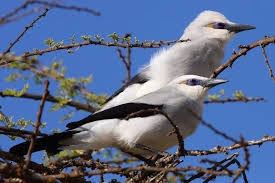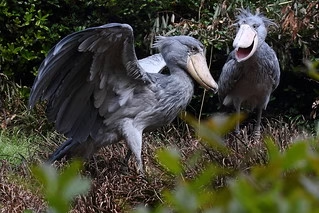What is the rarest bird in Uganda? Rarest bird in Uganda-Shoebill Stork-Uganda birdwatching-endangered birds UgandaMabamba Wetland.
What is the rarest bird in Uganda? Uganda is a birdwatcher’s paradise, brimming with over 1,000 bird species spread across its diverse landscapes. From the dense forests and mountain ranges to the expansive wetlands, the country offers a wide range of avian species to observe.
However, one bird stands out as the rarest and most elusive of them all—the shoebill stork. Known for its striking appearance and elusive nature, this bird has captivated birdwatchers around the world.
Let’s delve deeper into the world of the shoebill stork and explore what makes it the rarest bird in Uganda.
The Magnificent Shoebill Stork.
The Shoebill Stork (Balaeniceps rex) is one of the most unique and remarkable birds in Uganda’s avian world.
With its massive, shoe-shaped bill, sharp yellow eyes, and tall, elegant stature, the Shoebill looks like something out of a prehistoric era.
It is primarily found in Uganda’s swamps, particularly around the Mabamba Wetland on the shores of Lake Victoria and other secluded, swampy areas near Lake Albert.
This solitary bird is a master of camouflage, often blending perfectly with its surroundings as it waits motionless for its prey.
Standing at around 5 feet tall with a wingspan of up to 8 feet, the shoebill is hard to miss when it takes flight. However, its preference for dense, inaccessible swamps makes it difficult for even experienced birdwatchers to spot.
Why is the Shoebill Stork So Rare?
Despite its imposing size, the shoebill stork is a highly secretive bird, which is part of what makes it so rare. Its population in Uganda is dwindling, primarily due to the destruction of its wetland habitat.
Wetlands are being drained for agriculture, construction, and other human activities, reducing the available areas for the shoebill to live and breed.
The loss of these wetlands, combined with poaching and disturbance from human activities, has placed the shoebill on the International Union for Conservation of Nature’s (IUCN) Red List as a vulnerable species.
Estimates suggest that fewer than 5,000 shoebills remain in the wild, and Uganda is home to a significant portion of that population. This, combined with the bird’s preference for remote and inaccessible regions, has made spotting one a rare and special experience.
Physical Characteristics of the Shoebill Stork.
The Shoebill’s most striking feature is undoubtedly its enormous bill. Shaped like a large, curved shoe, the bill is a perfect tool for catching its prey, which primarily consists of large fish like lungfish, catfish, and sometimes even small crocodiles.
The Shoebill is an ambush predator, standing motionless in the water for long periods before suddenly striking with incredible speed.
In addition to its bill, the Shoebill Stork has pale blue-gray plumage, giving it a ghostly appearance when it moves through the swamps.
Its long, sharp legs are perfectly adapted for wading through the murky waters, while its large wings allow it to soar when needed.
Shoebill Stork Behavior and Diet.
The shoebill is a solitary bird, preferring to hunt alone in the dense wetlands where it stalks its prey.
Unlike other storks, the shoebill is not a social bird and has a solitary approach to both hunting and nesting.
It relies on its keen eyesight to locate prey and uses its strong, powerful bill to catch fish, frogs, and other aquatic animals.
The shoebill’s hunting strategy is slow and deliberate, waiting patiently for hours before striking, a testament to its patience and mastery of survival in challenging environments.
Their nests are built on floating platforms made of reeds in the middle of swamps, making them even harder to locate.
Shoebills are known to be fiercely protective of their nests, and their limited breeding areas have made them vulnerable to human encroachment.
Conservation Efforts to Protect the Shoebill
Uganda’s Shoebill Stork faces several threats, but there are efforts underway to protect its population.
Organizations like the Uganda Wildlife Authority (UWA) and local conservation groups are working to preserve wetland habitats by promoting sustainable agricultural practices, raising awareness about the importance of wetlands, and establishing protected areas like the Mabamba Wetland.
Tourism has become an important avenue for funding conservation efforts.
Birdwatching tours to see the shoebill in its natural habitat are popular, and these tours bring much-needed revenue to conservation projects.
Other Rare and Endangered Birds of Uganda
While the Shoebill is the rarest bird in Uganda, the country is home to several other unique and endangered species, including:
- The Grey Crowned Crane is Uganda’s national bird, found in wetlands and grasslands.
- The Endangered Ethiopian Bushcrow
 Found in remote areas of Uganda’s northern savannah, this bird is one of the most sought-after sightings for birdwatchers.
Found in remote areas of Uganda’s northern savannah, this bird is one of the most sought-after sightings for birdwatchers. - The handsome Francolin is a rare bird that inhabits the highland regions around the Virunga Mountains, often spotted near Uganda’s famous mountain gorillas.
Why Birdwatchers Flock to Uganda
Uganda’s position in East Africa makes it a hotspot for birdwatching, with a vast array of species spread across the country’s varied ecosystems.
The shoebill stork is one of the most coveted species, and spotting one in the wild is a highlight for many birdwatchers.
However, Uganda is also home to a remarkable number of other bird species, making it a must-visit destination for anyone passionate about avian life.
Uganda’s birdwatching tours not only offer the chance to see the Shoebill but also provide an opportunity to witness some of the world’s most beautiful and endangered bird species in their natural habitats. These experiences help raise awareness about conservation and the importance of preserving Uganda’s rich biodiversity.
The shoebill stork is a true marvel of nature and undoubtedly the rarest bird in Uganda.
Its dramatic appearance, elusive nature, and declining population make it a symbol of the fragility of Uganda’s wetland ecosystems.
While conservation efforts have made significant progress, much work remains to ensure the survival of the shoebill and other rare species that call Uganda home.
Birdwatchers who visit Uganda are not only rewarded with the chance to observe this magnificent creature but also contribute to the broader conservation efforts that will help protect the country’s invaluable wildlife for generations to come.




